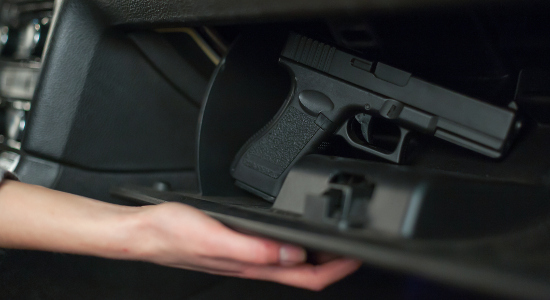
April 11, 2018 – The Wisconsin Supreme Court (6-1) has upheld the conviction of a man who transported a loaded handgun in his car’s glove compartment without a concealed carry license, rejecting an argument that the concealed carry statute is unconstitutionally vague when viewed in tandem with the “Safe Transport Statute.”
Brian Grandberry was convicted of carrying a concealed and dangerous weapon in violation of Wis. Stat. section 941.23(2), which says a person is guilty of a Class A misdemeanor for carrying a concealed handgun without a concealed carry license.
But Grandberry challenged the conviction, arguing that Wisconsin’s Safe Transport Statute is in conflict with the Concealed Carry Statute and the only way to resolve the conflict is to hold that compliance with the former is compliance with the latter.
The Safe Transport Statute, Wis. Stat. section 167.31(2)(b)1, says persons cannot place, possess, or transport a firearm unless “the firearm is unloaded or is a handgun.”
Under this statute, a person may possess or transport a loaded handgun in a vehicle without a concealed carry permit, so long as they meet the statute’s requirements.
Legal Transport or Illegal Concealed Carry?
In 2014, police stopped Grandberry’s vehicle. He told an officer he had a firearm in the glove compartment. The officer uncovered the loaded, .45 caliber, semi-automatic handgun and arrested Grandberry because he did not have a concealed carry license.
But Grandberry argued that he didn’t need a concealed carry license because the Safe Transport Statute says people can possess and transport loaded handguns in cars.
The circuit court entered a judgment of conviction for violating the concealed carry statute, and an appeals court affirmed, holding the Safe Transport Statute did not apply.
In State v. Grandberry, 2018 WI 29 (April 10, 2018), a 6-1 majority of the state supreme court ruled that Grandberry could have complied with both statutes if he either obtained a concealed carry license or placed his loaded handgun out of reach.
 Joe Forward, Saint Louis Univ. School of Law 2010, is a legal writer for the State Bar of Wisconsin, Madison. He can be reached by email or by phone at (608) 250-6161.
Joe Forward, Saint Louis Univ. School of Law 2010, is a legal writer for the State Bar of Wisconsin, Madison. He can be reached by email or by phone at (608) 250-6161.
The majority rejected Grandberry’s argument that the Concealed Carry Statute is vague because a person of ordinary intelligence would believe that transporting a loaded handgun in a vehicle’s glove compartment was legal under the Safe Transport Statute.
“We hold that the Concealed Carry Statute is not unconstitutionally vague because a person of ordinary intelligence has sufficient notice that carrying a concealed and dangerous weapon is unlawful unless one of the enumerated exceptions in the Concealed Carry Statute applies,” wrote Justice Michael Gableman.
The majority explained that the Concealed Carry Statute applies when a dangerous weapon is “within reach,” and there is no exception if someone is inside a vehicle.
Grandberry argued that a conflict is certain to exist because Wisconsin courts have ruled that guns located within the interior of a car are always within reach and many cars, including minivans, SUVs, and hatchbacks, don’t have a separate trunk.
“This would be a compelling argument if it were true,” wrote Justice Gableman. “As it is, however, his assertion is wholly unsupported by any statute, case law, or regulation.”
Gableman said analogies to Fourth Amendment cases that permit warrantless searches within the area of an arrestee’s “grab area” are not helpful because the cases are distinct.
That is, determining whether a Fourth Amendment “grab area” search is unconstitutional is a question of law, and whether a handgun is “within reach” for purposes of the Concealed Carry Statute is a question of fact.
“Accordingly, it would be improper for us to set forth an exhaustive list of nooks and crannies within the various and sundry configurations of motor vehicles wherein the armed, but unpermitted, motorist may place his dangerous weapon,” Gableman wrote.
Defining what areas of a motor vehicle are “within reach” is, absent legislation, Gableman said, “a question to be resolved on a case-by-case basis by finders of fact and by courts reviewing the sufficiency of the evidence in particular cases.”
Concurrence and Dissent
Justice Daniel Kelly agreed with the majority that Grandberry’s conviction should be upheld but wrote a separate concurrence to argue that the majority opinion creates an “unnecessary ambiguity about what it means to ‘carry’ a weapon.”
“We said that what is ‘within reach’ for Fourth Amendment purposes is something different from ‘within reach’ for purposes of the Concealed Carry Statute,” Kelly wrote.
“The court chose synonymous phrases to describe the same concept and then asserted the synonyms created a substantive difference,” Justice Kelly continued.
He noted that the Concealed Carry Statute “puts at risk all those who not have concealed carry permits who nonetheless bring their handguns to shooting ranges.”
Justice Rebecca Bradley dissented. She said application of the Concealed Carry Statute and the Safe Transport Statute is unconstitutionally vague in this situation.
“The interplay of these statutes does not provide clear notice or effective direction on how to comply with the law, and the lack of clarity allows for selective enforcement. …”
“The majority’s interpretation of the carry concealed weapons statute … and the safe use and transportation of firearms and bows statute … criminalizes hunters transporting long guns to hunting grounds, domestic violence victims transporting handguns to shooting ranges, and archers transporting crossbows to archeries,” R. Bradley wrote.
